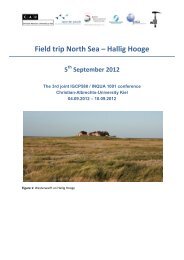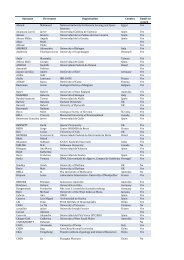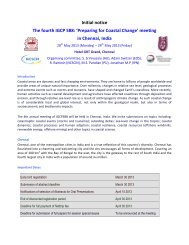Conference program and abstracts - Coastal-Change.Org
Conference program and abstracts - Coastal-Change.Org
Conference program and abstracts - Coastal-Change.Org
You also want an ePaper? Increase the reach of your titles
YUMPU automatically turns print PDFs into web optimized ePapers that Google loves.
High Resoluation Holocene Climatic Registers from the<br />
Red S<strong>and</strong>s of South Coast of India<br />
A.Vidyasakar ,S. Srinivasalu, Linto Alappat, P.Morthekai<br />
ABSTRACT<br />
The ubiquitous Teri deposits or red s<strong>and</strong>s of semiarid-southern-coastal-<br />
Tamil Nadu, chiefly noticed to occur from Tirunelveli to Kanyakumari ,<br />
show unique shades of red ranging from yellowish red (5YR4.5/6) to dark<br />
reddish brown (2.5YR ¾) <strong>and</strong> dark red (10R 3/6). The autochthonouscalcareous-rhizoliths,<br />
chiefly noticed in Sattankulam, Eluvilai, Sayarpuram<br />
<strong>and</strong> muttom teris, dominantly show a discordant relationship with primary<br />
sedimentary structures <strong>and</strong> morphologies (size, shape <strong>and</strong> sense of<br />
branching) reminiscent of calcified-roots, need a much warmer climate<br />
(like the current climate) for their formation. Red s<strong>and</strong>s were closely<br />
examined using remote sensing, stratigraphy, Geochemistry,<br />
sedimentology, optically stimulated luminescence (OSL) dating, <strong>and</strong><br />
magnetic susceptibility. Besides, teris can grouped into ITDs (inl<strong>and</strong> teri<br />
deposits, area= 33.0 km2) <strong>and</strong> CTDs (coastal teri deposits, area = 437.0<br />
km2). The inl<strong>and</strong> teri sediments have higher clay <strong>and</strong> silty-s<strong>and</strong><br />
component than the coastal <strong>and</strong> near-coastal teri, suggesting that these<br />
sediments were deposited by the fluvial process during a stronger winter<br />
monsoon around >15 ka. The coastal teri dunes were deposited prior to<br />
11.4±0.9 ka, <strong>and</strong> the near-coastal dunes aggraded at around 5.6±0.4 ka<br />
The red colour <strong>and</strong> matrix of authigenic clays (viz., kaolinite <strong>and</strong> illite in the<br />
fine fraction), products of pedogenic weathering, do strongly point to a<br />
wetter or<br />
humid climate which enables release of red pigment (or now hematite)<br />
by the chemical alteration (intrastratal solution) of iron bearing heavy<br />
minerals like the opaque ilmenite, red alm<strong>and</strong>ine-garnet <strong>and</strong> pyroxenes<br />
of the heavy fraction as well as authigenic formation of clays from<br />
feldspar in the frame work grains <strong>and</strong> matrix. Five different Samples<br />
location of samples were collected by trench sampling at highest of 12m<br />
depth in muttom ,6.6m at servaikaranmadam, 7.4 m at thoopu villa, 3.5 m<br />
at Katchanavilai, <strong>and</strong> 4.5 m at Idachivilai at 10cm interval the samples<br />
have collected <strong>and</strong> have worked on it. Onset of s<strong>and</strong> aggradation as<br />
early as ~25ka on the east <strong>and</strong> west coast <strong>and</strong> dune reddening was<br />
favored by stability dune to humid climate at ~9ka <strong>and</strong> after ~4ka. The<br />
s<strong>and</strong> aggradation in the west coast which is controlled by s<strong>and</strong><br />
availability from the on shore during late Pleistocene to early Holocene<br />
was seized during transgression at ~8ka. The upper part of the section<br />
shows two distinct intervals of humid events between 17 <strong>and</strong> 14ka, as<br />
evidence from the enhanced MS values, OM <strong>and</strong> clay content in the soil.<br />
The Fourth IGCP 588: PREPARING FOR COASTAL CHANGE 35





